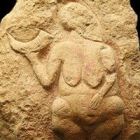Female Magic
Cory Panshin on July 29, 2009In my previous post, I suggested that the making of string figures goes back 70,000 years or more and represents both an ancient mode of performance art and a very early exercise in abstract thinking. However, string figures are far more than that. They are also a form of magic.
Nearly a hundred years ago, the mathematician W.W. Rouse Ball delivered a lecture on string figures in which he noted:
Among existing aborigines, it is usually the women who teach the passtime to the children, and in most cases now-a-days the lads and men, though familiar with the methods used, do not of their own accord make designs in the presence of strangers. …
The Eskimo … have a prejudice against boys playing the game for fear it should lead to their getting entangled with harpoon lines, and hold that such figures, if made at all should be constructed in the autumn so as to entangle the sun in the string and delay the advent of the long winter night.
The notion that knotted strings can be used as a form of voodoo to entangle and hold things back is both very old and more widely distributed than string figures themselves. For example, the Scottish ballad “Willie’s Lady” tells of a man whose mother is jealous of her son’s young wife and uses several kinds of binding magic to prevent the girl’s baby from being born. With the aid of a friendly household spirit, Willie manages to learn the secrets of this “vile rank witch” and successfully undoes the binding spells:
O Willie has loosed the nine witch knots
That was amo that ladie’s locks …And Willie has loosed her left-foot shee,
And letten his ladie be.And now he’s gotten a bonny young son,
And mickle grace be him upon.
The ballad suggests both the positive and negative sides of what is sometimes known as female magic. In its positive aspect, it has a close association with midwifery and childbirth. But in its negative aspect, it is feared — particularly by men — as “vile” witchcraft that can cause crops to fail to grow and cows to cease giving milk. In both aspects, it is closely bound up with the imagery of knotting and unknotting, binding and releasing.
Early 20th century anthropologists, most of whom were male, didn’t take much interest in female magic — and probably wouldn’t have been allowed to share its secrets even if they had — but recent studies have brought increased awareness of this special area of female power, which exists even in strongly male-dominated cultures.
 It has been suggested, for example, that the “Venus” figurines of Paleolithic Europe — which depict women in what appears to be an advanced stage of pregnancy — were meant for use in some form of female magic.
It has been suggested, for example, that the “Venus” figurines of Paleolithic Europe — which depict women in what appears to be an advanced stage of pregnancy — were meant for use in some form of female magic.
Those figures have some extremely interesting associations. Several of them — notably the Venus of Willendorf and the Venus of Laussel — bear traces of ochre and are thought to have originally been entirely coated with it. This is the same mysterious red mineral that was used some 70,000 years ago both to brew up an ancient form of glue and also as the vehicle for the earliest known artwork, a series of incised lozenges strongly resembling a string figure.
Indeed, the Venus figures themselves are often described as lozenge-shaped because of their bulging hips and bellies and tiny heads and feet — which brings them even closer symbolically to that artwork of nearly 50,000 years earlier.
If this association of string figures, ochre, and female magic is valid, than a fourth element in the symbolic complex must have been the moon. The moon is commonly regarded as female in archaic cultures because of the synchronization of its phases with women’s menstrual cycle, and it is also closely associated with female magic.
The common theme that runs throughout this complex is transformation. The sequence of transformations needed to produce a string figure. The alchemical transformation of ochre and acacia gum into glue. The transformation of the moon from new to full and back again. And the transformations that are part of the reproductive lifetime of every woman but which have no counterpart in the lives of men.
Related:
A listing of all my posts on deep prehistory can be found here.
A general overview of the areas of interest covered at this blog can be found here.
A chronological listing of all entries at this blog, with brief descriptions, can be found here.
Read the Previous Entry: The Algorithms of StringRead the Next Entry: The Invention of Society




